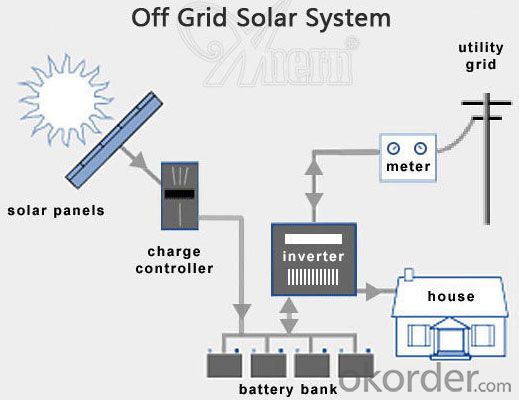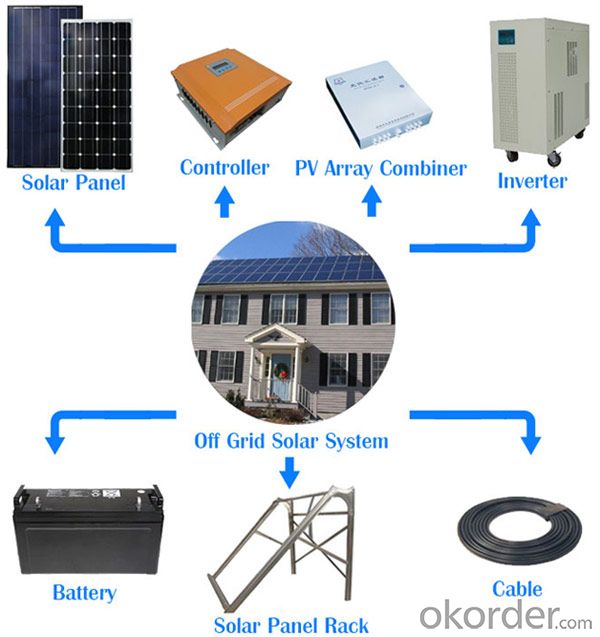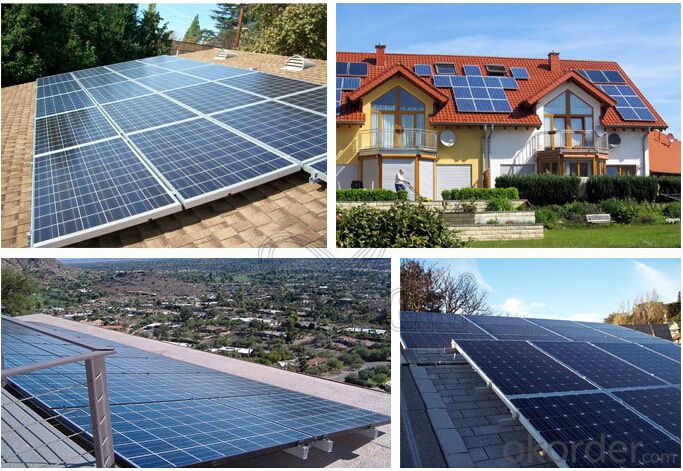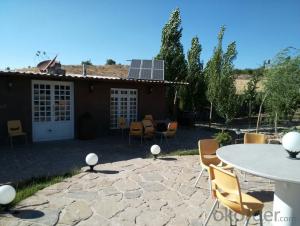Off-Grid Solar Power System 4KW High Efficiency
- Loading Port:
- China main port
- Payment Terms:
- TT OR LC
- Min Order Qty:
- 1 pc
- Supply Capability:
- 10000 pc/month
OKorder Service Pledge
OKorder Financial Service
You Might Also Like
1.Description of Product
Off-Grid Solar Power System is consisted of solar panel, solar charge controller, inverter, battery, mounting rack and cables.
(1).Grid-connected, send power to city grid
(2).MPPT technology, wide range of working voltage
(3).Simply Wiring, easy installation, customized design for your projects
(4).Low investment & long term feedback

2. Off-Grid Features
1. Off grid solar power system is mainly used for application with relatively-small power consumption, and the areas have no grid network coverage, or grid power is unstable or outage condition.
2. It’s composed of solar panels, hybrid solar inverter, battery bank, solar panel mounting racks, and other accessories required fora complete home solar power system.
3. The battery bank gives a stable power output to the solar inverter which converts DC to AC to power loads, and provides power backup in rainy or cloudy days.
4. The solar panels generate electricity at daytime and charge the battery bank .
5. The off grid home solar power system provides grid power bypass in case of battery power shortage when sunshine is not enough.
6. All the off grid home solar power system configurations are worked out by scientific calculation and design.
Ref No. | 4KW |
Solar Panel | Type: Monocrystalline Silicon PV Module Max Power: 250W QTY:12 pcs |
Controller-Inverter Integrator | Rated Ouput Power: 4000W Rated DC Voltage: 48V QTY:1 pcs |
Battery | 12V/150AH per piece QTY:12 pcs |
Solar Panel Rack | Roof type mounting rack, anodized aluminum material, including complete fittings (Other type of racks can be customized as per client's requirement) QTY:1 pcs |
Cables | International standard, with specification suitable for solar system, BV1*10 QTY:80m |
3.The Pictures of Product


4.FAQ
Q1: What is the business type for the company?
A1: We are one of the biggest manufacturers inBejing.Chnia. Which is a high tech PV enterprise dedicated to the research, development, production and sales..
Q2: How long solar panel warranty can you offer?
A2: 10-Year product warranty,25-year linear power output warranty
If there is any quality problem, we will pay for freight and send free parts to you.
Q3: How many certificates do you have?
A3: We have 16 certificates,such as CE, TUV, UL, and so on.
Q4: Can I be the agent for you?
A4: Yes,We can discuss some information.
Q5: How to get a sample?How can cooperation with us
A5: contact us now.
- Q:How do solar energy systems impact the energy poverty gap?
- Solar energy systems have the potential to significantly impact the energy poverty gap by providing clean and affordable electricity to those who do not have access to reliable energy sources. Energy poverty refers to the lack of access to electricity and modern energy services, which affects millions of people worldwide. One of the key advantages of solar energy systems is their ability to generate electricity in a decentralized manner, making them suitable for off-grid and rural areas where connecting to the traditional power grid is often challenging and costly. These systems can be easily installed and are scalable, allowing for customized solutions based on the energy needs of a particular community or household. By harnessing the power of sunlight, solar energy systems can provide a sustainable and reliable source of electricity, reducing the dependence on traditional fossil fuels that are often expensive and environmentally harmful. This, in turn, helps to alleviate the financial burden on individuals and communities, as solar energy can be generated for free once the system is installed. Furthermore, solar energy systems also have the potential to stimulate economic development in energy-poor regions. By providing access to electricity, solar systems enable the establishment of small businesses, such as charging stations for mobile phones, refrigeration units for storing perishable goods, or even micro-grids to power communal services like schools and healthcare facilities. These economic activities can create job opportunities and improve the overall quality of life in these areas. In addition to economic benefits, solar energy systems also contribute to environmental sustainability. By generating electricity from renewable sources, they help reduce greenhouse gas emissions and mitigate climate change. This is particularly important in energy-poor communities that often rely on traditional energy sources, such as kerosene lamps or diesel generators, which emit harmful pollutants and contribute to air pollution. In conclusion, solar energy systems have a profound impact on the energy poverty gap by providing clean, affordable, and sustainable electricity to those who lack access to modern energy services. They offer a decentralized and scalable solution that can stimulate economic development, improve quality of life, and contribute to environmental sustainability.
- Q:Are there any government incentives or rebates for installing solar energy systems?
- Yes, there are government incentives and rebates available for installing solar energy systems. These incentives vary by country and region, but they often include tax credits, grants, and rebates that aim to encourage the adoption of renewable energy sources like solar power. These incentives can help offset the upfront costs of installation and make solar energy systems more affordable for homeowners and businesses. It is recommended to check with local authorities or renewable energy agencies to learn about specific incentives available in your area.
- Q:How does the size of solar panels impact energy production?
- The size of solar panels directly impacts energy production, as it determines the amount of sunlight that can be captured and converted into electricity. Larger solar panels have a higher surface area, allowing them to absorb more sunlight and generate more electricity. This means that larger panels can produce more energy compared to smaller ones. Additionally, larger panels can accommodate more solar cells, which further increases their energy production capacity. However, it is important to note that the size of solar panels should be balanced based on available space, cost, and specific energy needs.
- Q:Can solar energy systems be used for powering off-grid agricultural processing facilities?
- Yes, solar energy systems can be used to power off-grid agricultural processing facilities. These systems can generate electricity through photovoltaic panels, which can be utilized to power various equipment and machinery required for processing agricultural products. Solar energy is a sustainable and renewable source, making it an ideal solution for off-grid facilities in remote agricultural areas. Additionally, solar energy systems can be combined with energy storage solutions to ensure a continuous and reliable power supply even during periods of low sunlight. Overall, solar energy systems offer a viable and environmentally-friendly option for powering off-grid agricultural processing facilities.
- Q:Can solar energy systems be used in areas with limited skilled labor?
- Yes, solar energy systems can be used in areas with limited skilled labor. Solar energy systems are designed to be user-friendly and require minimal technical expertise for installation and maintenance. Additionally, there are various training programs and resources available that can help train local individuals in the installation and maintenance of solar energy systems, enabling them to acquire the necessary skills. This allows for the adoption of solar energy in areas with limited skilled labor, promoting renewable energy usage and providing economic opportunities for the local population.
- Q:What is the payback period for installing a solar energy system?
- Installing a solar energy system can have a variable payback period, depending on factors such as the initial cost, energy generation, and local electricity rates. On average, residential solar systems typically take between 5 to 10 years to break even. During this period, the savings on electricity bills gradually offset the installation costs. Once the payback period is completed, the system can provide free or significantly reduced electricity costs for the remaining 25 to 30 years of its lifespan. It's worth mentioning that government incentives, tax credits, and net metering programs can further shorten the payback period and enhance the overall financial advantages of solar installation.
- Q:Can a solar energy system be used for heating and cooling?
- Yes, a solar energy system can be used for heating and cooling. Solar thermal systems can be used to provide heat by capturing and utilizing the sun's heat energy. These systems typically consist of solar collectors that absorb the sun's rays to heat a fluid, which is then used to heat water or air. The heated water can be used for various purposes, such as space heating, domestic hot water, or even for industrial processes. Additionally, solar energy can also be used for cooling through the use of solar-powered air conditioning systems. These systems utilize solar energy to power absorption chillers or heat-driven chillers, which cool the air by absorbing heat from it. This process is typically more energy-efficient than traditional air conditioning systems that rely on electricity. Furthermore, solar energy can also be harnessed for passive cooling. Passive solar cooling techniques involve designing buildings to maximize natural ventilation and shading, reducing the need for mechanical cooling systems. This can be achieved through techniques such as strategic building orientation, proper insulation, and the use of shading devices like awnings or overhangs. Overall, solar energy systems can indeed be used for both heating and cooling, offering sustainable and cost-effective solutions for meeting our thermal comfort needs.
- Q:Can solar energy systems be used for outdoor recreational activities?
- Yes, solar energy systems can certainly be used for outdoor recreational activities. Solar panels can be installed on RVs, boats, and camping equipment to provide a sustainable and renewable power source for lighting, charging devices, running small appliances, and more. Additionally, solar-powered outdoor lights and solar-powered phone chargers are commonly used in camping, hiking, and other outdoor activities.
- Q:What is the role of solar-powered ventilation systems in solar energy systems?
- The role of solar-powered ventilation systems in solar energy systems is to improve the overall efficiency and performance of the system. These ventilation systems help in regulating the temperature and air quality within the solar energy system, preventing overheating and reducing the need for additional cooling mechanisms. By utilizing the power of the sun, these ventilation systems provide sustainable and environmentally friendly solutions for maintaining optimal conditions in solar energy systems.
- Q:What is a solar thermal system?
- A solar thermal system is a technology that uses sunlight to heat water or other fluids for various applications such as heating buildings, providing hot water, or generating electricity. It involves capturing solar energy using collectors, typically mounted on rooftops, and transferring it to a storage tank or heat exchanger where it can be used or converted into usable energy.
1. Manufacturer Overview |
|
|---|---|
| Location | |
| Year Established | |
| Annual Output Value | |
| Main Markets | |
| Company Certifications | |
2. Manufacturer Certificates |
|
|---|---|
| a) Certification Name | |
| Range | |
| Reference | |
| Validity Period | |
3. Manufacturer Capability |
|
|---|---|
| a)Trade Capacity | |
| Nearest Port | |
| Export Percentage | |
| No.of Employees in Trade Department | |
| Language Spoken: | |
| b)Factory Information | |
| Factory Size: | |
| No. of Production Lines | |
| Contract Manufacturing | |
| Product Price Range | |
Send your message to us
Off-Grid Solar Power System 4KW High Efficiency
- Loading Port:
- China main port
- Payment Terms:
- TT OR LC
- Min Order Qty:
- 1 pc
- Supply Capability:
- 10000 pc/month
OKorder Service Pledge
OKorder Financial Service
Similar products
New products
Hot products
Hot Searches
Related keywords




























